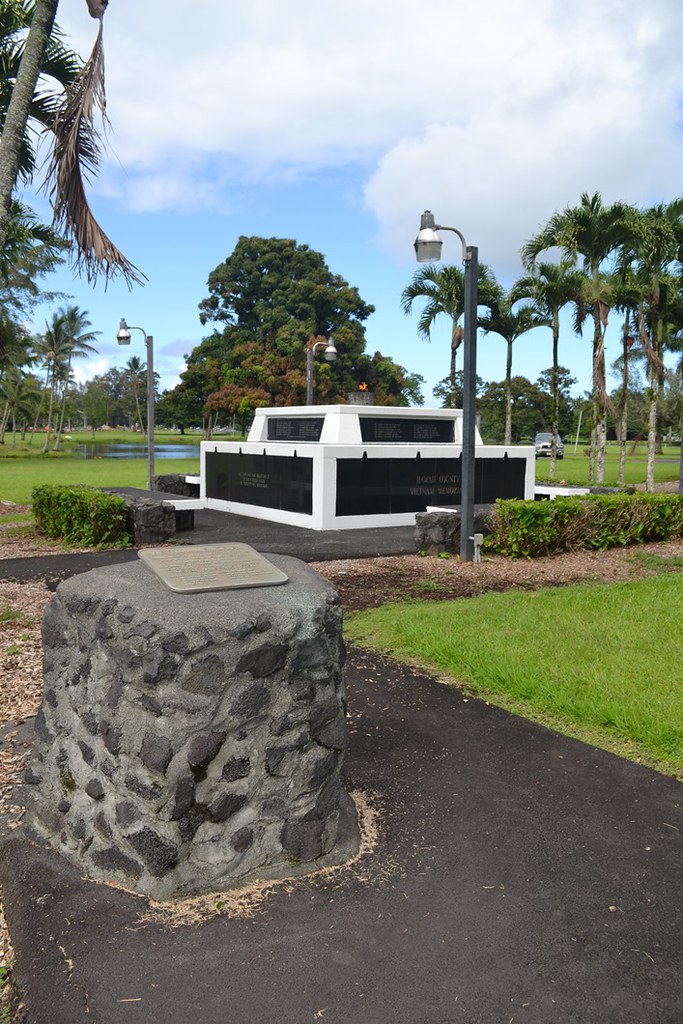

... Gần nơi VietNam Memorial có tượng đài Vua Kamehameha Đệ Nhất - Ông sinh trưởng tại Big Island này, thuộc vùng Waipio Valley về hướng bắc của Hilo . Waipio Valley đẹp vô cùng , thảo nào nơi đây là thánh địa của vua chúa ... Nếu tôi còn thời gian ,tôi sẽ gửi bạn vài tấm hình chụp từ Waipio Valley ....
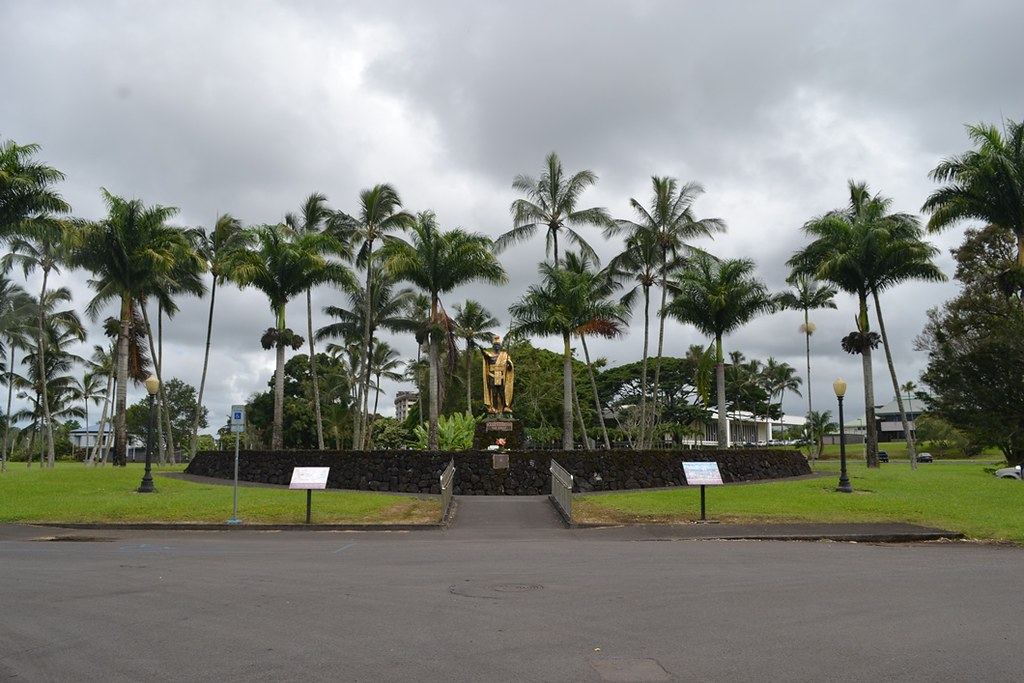
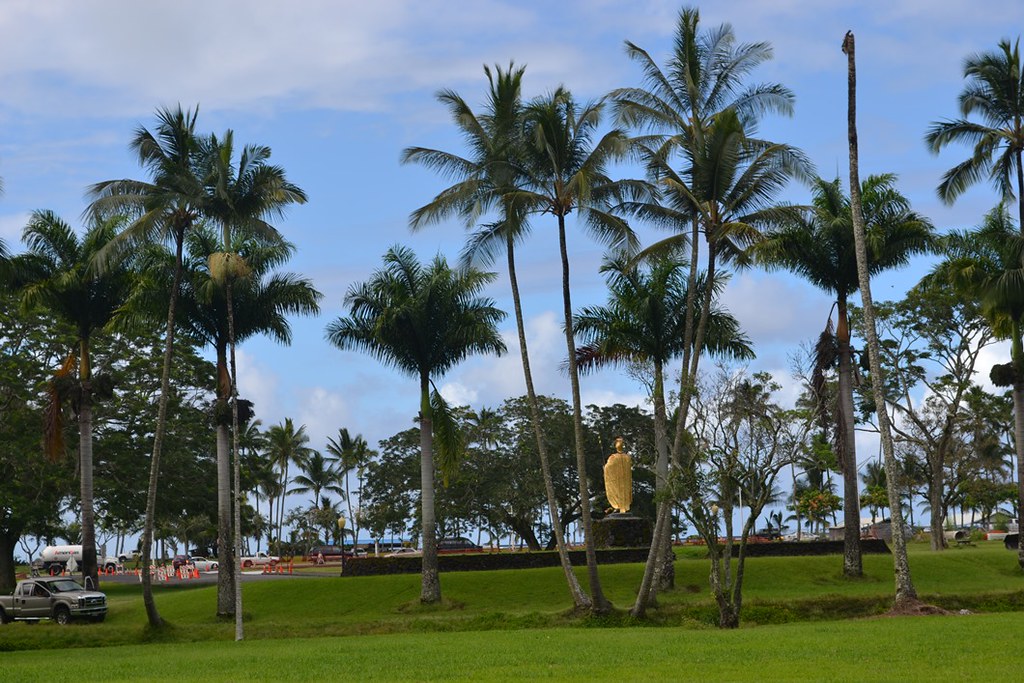
Tượng đài Đại đế Kamehameha của dân Hawaii


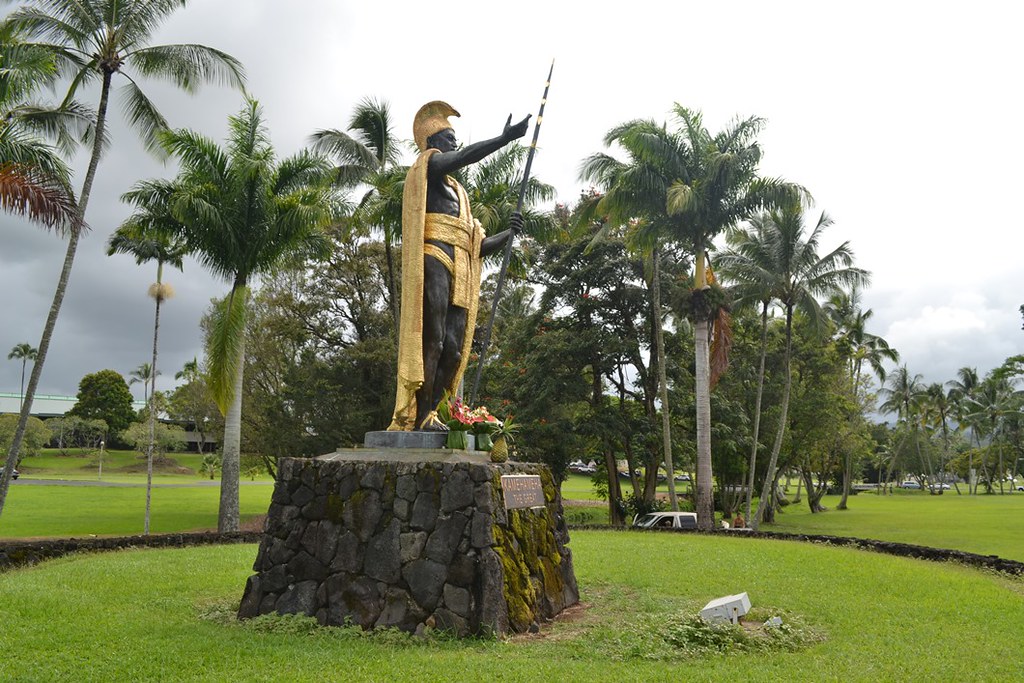
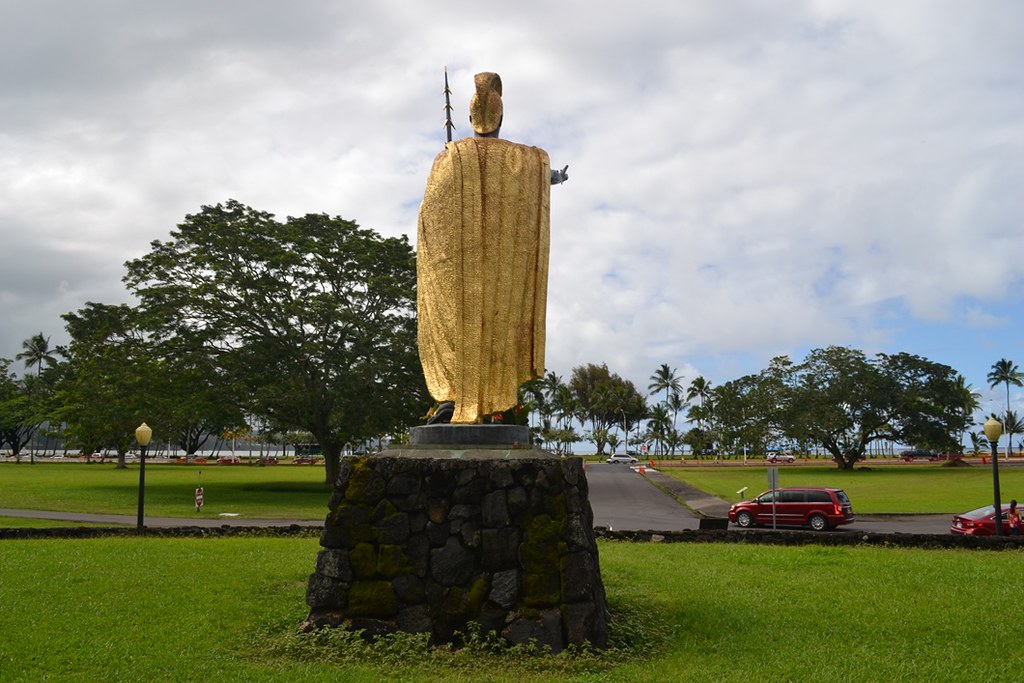
Vua Kamehameha Đệ Nhất thăm dân của ông lập nghiệp tại Hilo Bay này . Tấm bảng khó đọc quá .
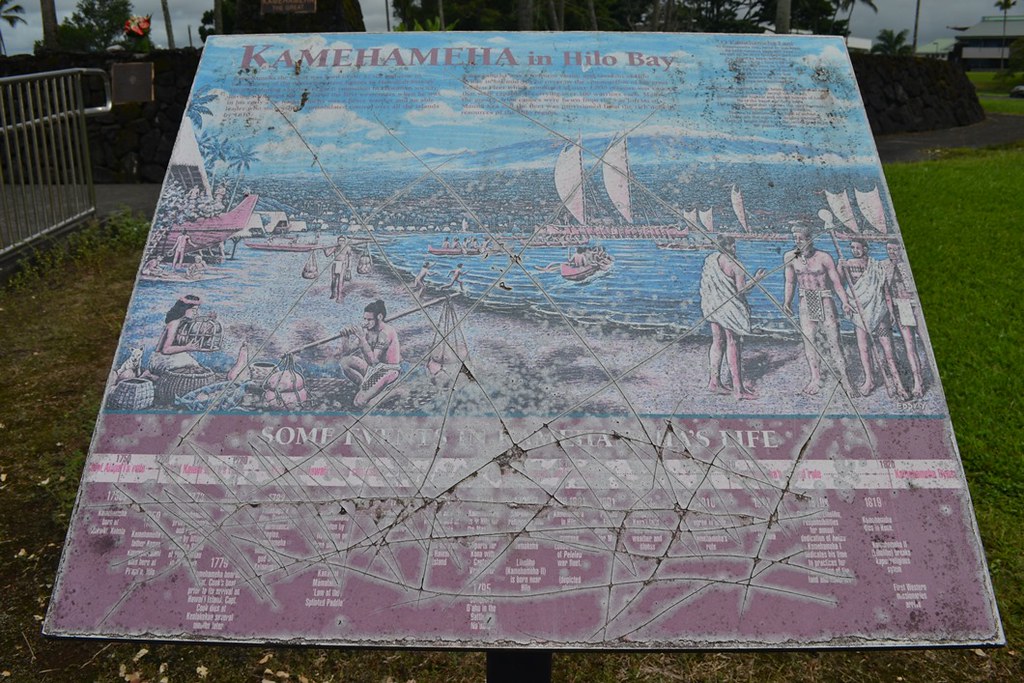
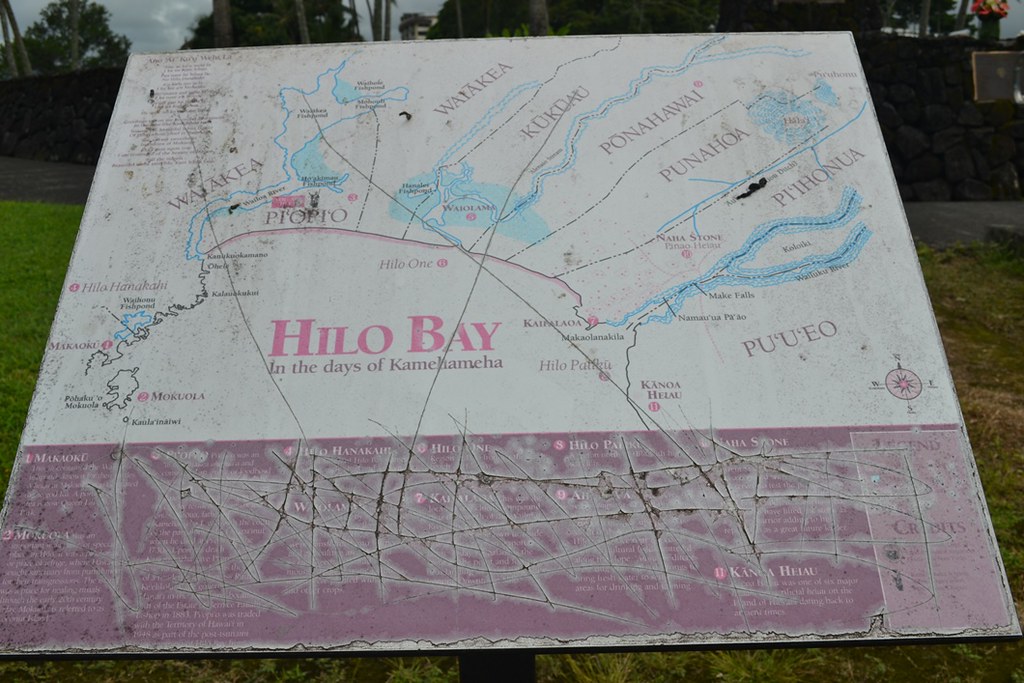
Tôi sưu tầm vài sự kiện chính về Big island , Hawaii này . Xin tạm để bằng tiếng Anh, khi nào tôi có thời gian tôi sẽ tạm dịch sang tiếng Việt cho bạn xem
| 1100 | Polynesians arrived in the Hilo area. They inhabited Hilo Bay establishing farms and fishing communities. |
| 1778 | Captain Cook moored in Kealakekua Bay on the Kona coast of the island of Hawaii. The Hawaiian islands’ population is estimated to be between 200,000 to 400,000 at that time. The people had a rich culture and had explored the oceans yet had no written language, metal or clay for pottery. |
| 1789 | Chinese arrived in Hawaii. First contact with China dates back to 1787 when an English merchant stopped in Hawaii on his way from N. Am to China and met with the chief of Kauai who accompanied him to Canton, China on his trip to trade furs for Chinese goods. On his return, in 1789, he stopped in Hawaii bringing with him 50 Chinese carpenters, several whom stayed on the Big Island under the charge of Kamehameha the 1st |
| 1796 | Kamehameha the Great came to Hilo to build 800 war canoes to help him conquer the Hawaiian Islands. |
| 1802 | Chinese immigrants are credited with being the first in Hawaii to refine sugar. Initial efforts failed, but the knowledge of how to refine and make money from sugar came from Chinese in Hawaii. |
| 1810 | Kamehameha the Great completed the unification of Hawaii beginning the transformation from a feudal society to a constitutional monarchy. |
| 1811 | Kamehameha set up an agreement with Boston ship captains to export sandalwood from Hawaii to China with Kamehameha receiving 25% of the profits |
| 1812 | The British blockaded Hawaii for 2 years as a result of the War of 1812. |
| 1817 | Kamehameha bought the ship Columbia for the price of two ships of sandalwood. |
| 1820 | American missionaries arrived in Hilo. They taught reading and writing to the Hawaiians |
| 1824 | Liholiho, King Kamehameha II, and one of his wives died of illness while in London on a visit. |
| 1825 | Kauikeaouli, younger brother of King Kamehameha II becomes King Kamehameha III at age 9. |
| 1826 | Hawaiian is standardized as a written language with help from the missionaries that created the language from the sounds they heard. |
| C. Brewer & Co (later known as one of Hawaii’s Big 5) is founded by Captain James Hunnewell originally to trade sandalwood with China. Later Charles Brewer joined the company and focused on supplying whaling ships. | |
| 1830 | Trade in sandalwood had completely collapsed and Hawaiian forests were exhausted through continuous pillaging of the forests without protecting the young trees. |
| 1840 | Kamehameha III created the first Hawaiian constitution subjected Kamehameha and his heirs to the law. It established a house of nobles and an elected house of representatives. |
| 1845 | Theo H Davies & Co (later known as one of Hawaii’s Big 5) was founded by two Englishmen originally as a small trading company called Starkey, Janion & Co. Davies took control in 1881 and added sugar plantations to the company interests. |
| 1848 | The Mahele of 1848 divided the land between the King, the nobles (ali’i) and the people and for the first time permitted private ownership of the land. The result was that land ownership started transferring to European and American planters. |
| 1849 | German immigrant Heinrich Hackfeld and his brother in law founded H. Hackfeld & Co. which became an agent of sugar plantations. The company was later to become the foundation of Amfac, later known as one of Hawaii’s Big 5) |
| 1853 | Indigenous Hawaiians made up 97% of the islands population. |
| 1857 | Metcalf Plantation, was started on the outskirts of Hilo at Kaupakuea by Theophilus Metcalf and the first sugar cane crop was harvested in 1859. |
| 1868 | US-based fruit and sugar plantations in Hawaii started recruiting Japanese immigrants, as laborers for the sugar cane and pineapple plantation sending agents to Japan to sign long-term contracts with young men. |
| King Kamehameha V granted a charter for the “First Foreign Church of Hilo” in 1868 (now First United Protestant Church). While constructing the church, a near-magnitude 8 earthquake hit the island in April 1868, which lowered the foundation that was under construction by more than a foot. | |
| 1869 | A small parish school of 42 students was established in Hilo for the purpose of teaching English to native Hawaiians. The school was named St. Joseph. |
| 1870 | Alexander & Baldwin (later known as one of Hawaii’s Big5) was founded by sons of medical missionaries that came to Hawaii in 1831. They purchased land to grow sugar cane |
| 1874 | David Kalakaua, known as the Merrie Monarch, became King of the Hawaii Kingdom. He reigned until his death in 1891. King David Kalakaua was a patron of the arts and restored extinct, cultural traditions of the Hawaiian people including myths and legends and the hula which had been forbidden for 70 years by missionaries. |
| 1874 | The Metcalf plantation outside of Hilo was purchased and the name changed to Pepeekeo Sugar Company. Pepeekeo Sugar Company (also known as the Hilo Coast Processing Company) extended four miles along ocean cliffs and from three to 18 miles mauka to 1600 feet in elevation on the slopes of Mauna Kea. |
| 1881 | The Pepeekeo Sugar Company’s crop was estimated at 1800 tons and the factory was constructed of corrugated iron buildings with machinery manufactured by Honolulu Iron Works. |
| 1887 | The Hawaii constitution was modified. Called the Bayonet Constitution, the house of Nobles for the first time had to be elected and reduced the Kings veto power. |
| 1889 | October 14, 1889 Pepeekeo Sugar Company was incorporated, with H. Hackfeld & Co. as agents. T.H. Davies & Co. served as agents from 1892 to 1904, when C. Brewer & Co. purchased control. |
| The Hilo Besuin Buddhist worship was built in Hilo. Hilo Betsuin is the oldest Shin organization in the West. | |
| 1890 | Japanese immigrants came to a Hawaii controlled almost exclusively by large commercial interests. Most Japanese immigrants were put to work chopping and weeding sugar cane on vast plantations, many of which were far larger than any single village in Japan. The workday was long, the labor exhausting, and, both on the job and off, the workers' lives were strictly controlled by the plantation owners. Plantation workers were legally bound by 3- to 5-year labor contracts, and "deserters" could be jailed. For many Japanese immigrants, most of whom had worked their own family farms back home, the relentless toil and impersonal scale of industrial agriculture was unbearable, and thousands fled to the mainland before their contracts were up. |
| 1893 | The Hawaiian Monarchy is overthrown precipitated by Queen Lili’uokalani’s proposed new constitution to restore power for the monarchy to appoint the house of nobles and veto constitutional amendments. |
| 1894 | Castle &Cook (later known as one of Hawaii’s Big 5) was incorporated as a department store that sold farm tools, sewing equipment and medicine. Castle and Cook started investing in Hawaii’s sugar industry running plantations in Kohala and Haiku and became one the Hawaii’s Big 5 Territorial companies.. Later it invested in Matson Navigation Company along with three other companies in Hawaii and invested in Hawaiian Pineapple Company later renamed Dole Food Company. |
| 1898 | The Territory of Hawaii was created on July 7, 1898 when congress passed the Newlands Resolution. Contract labor was forbidden and children born on the island were American citizens. The territory economy was based on sugar and pineapple. |
| 1899 | Hamakua Sugar Company was formed as a consolidation of 7 original plantations: Hamakua Mill Company, Honokaa Sugar, Kaiwiki Sugar, Kukaiau Plantation Co., Laupahoehoe Sugar, Paauhau Sugar Plantation and Pacific Sugar Mill. |
| The Hilo wharf was built | |
| Mauna Loa erupted threatening Hilo | |
| 1900 | Hilo Railroad Company begins operations on the Big Island. |
| 1901 | The Japanese government lifted the restriction on immigration to Hawaii. Within 5-6 years more than 40,000 Japanese came. Many moved on the west coast of the United States. |
| 1901 | Willie Shipman bought a mansion in Hilo, where his wife, Mary, had guests that included Lili’uokalani, the last queen of Hawaii and the famous author Jack London |
| 1903 | Five kingdom-era corporations benefited from annexation of Hawaii by growing to huge conglomerations overnight:Castke & Cooke, Alexander & Baldwin, C. Brewer & Co, Amfac, and Theo H. Davis & Co.Together, the companies ruled the Hawaiian economy as the “Big Five”. The companies cooperated to keep prices of their products high and the extent of power that they enjoyed was considered by some as equivalent to an oligarchy. |
| 1903 | On January 13, 1903 one hundred and two Korean immigrants disembarked the SS Gaelic for the sugar cane fields of Hawaii. Though Korean immigration to Hawaii was brought to a halt by Japanese interference, between the years 1899 through 1905 more than 7,000 Korean immigrated to Hawaii. |
| 1905 | During the California gold rush, whaling vessels showed up in Hilo to stock up with fresh water and supplies. As many as 50 to 100 ships were docked in Hilo at a time. The fleets eventually stopped coming to Hilo after the Civil war due to being mostly destroyed by confederate ships. |
| 1907 | A “Gentlemen’s Agreement” was drawn up between the US and Japan and the Japanese immigrants to Hawaii were stopped. With the passage of the Immigration Act in 1924, Japanese were excluded from immigration to the US |
| 1909 | The Great Strike occurred by Japanese laborers in Oahu who demanded higher wages and an end to the discriminatory wage differential based on ethnicity. To counter the strike, Filipinos were recruited to replace the vacated jobs. By 1909, 639 Filipino workers had come to Hawaii and by 1910, there were 2,915. From 1911 to 1920, an estimated 3,000 Filipino workers arrived yearly |
| 1910 | The Pepeekeo Sugar Company’s annual sugar yield was 8,000 tons processed by a 9-roller mill with a capacity to grind 60 tons of cane per day. The warehouse could store 24,000 bags of sugar, which were loaded onto interisland steamers by steel cables from the sea cliff. Plantation fields were connected by good dirt roads and the harvested cane was delivered to the mill by railroad cars and 15 miles of stationary flumes. There were 700 employees at Pepeekeo Sugar, all of whom worked on the day labor system, there being no contract laborers at the plantation. |
| 1911 | Hawaii Volcano Observatory founded by Thomas Jaggar from MIT and Frank Perret. |
| 1914 | Homesteaders near Hilo were using 625 acres to grow cane that was processed at the Pepeekeo Sugar Company mill. Eucalyptus trees were planted as windbreaks, protecting the fields near the ohia forests. The Waiaama stream and Kauku Hill provided water and turned a water wheel to generate power. |
| 1916 | Hawaii National Park established. Prince Jonah Kuhio Kalanaiana'ole, introduced the Hawai`i National Park bill, establishing both Kilauea and Haleakala areas as park lands. President Wilson signed the bill into law, creating the country's 12th national park. |
| 1917 | Former Queen Lili'uokalani dies. |
| 1918 | H. Hackfeld & Co. was seized by the US government along with other German assets and sold to a consortium of Hawaii business men. The consortium changed the name to American Factors (Amfac). At its peak Amfac owned 60,000 acres of land and was a dominate sugar company and founder of Liberty House department stores. |
| 1919 | The Hawaii plantation labor force was 54.7% Japanese and 22.9% Filipino. During the 1920s an average of 7,630 Filipinos arrived in Hawaii annually. In the 1930s, Filipinos had replaced the Japanese as the largest ethnic group of workers in the plantations. A 1919 a Philippine investigator, reported that the Filipino plantation workers worked at least 10 hours a day, six days a week, 27 days a month for 90 cents a day or $20/month. The worked under extremely difficult conditions with poor housing and complained of abusive plantation foreman. |
| 1920 | Japanese and Filipino organizers joined with Chinese, Spanish, and Portuguese laborers, to form the Hawaii Laborers' Association, the islands' first multiethnic labor union. Japanese and Filipino labor leaders staged a strike on Oahu. The strike ended after a six month standoff by which time the workers received increased wages, abolishment of wage differentials, and changes in the bonus system. |
| 1923 | By 1923 indigenous Hawaiians population had dwindled to 16%. The largest percentage of Hawaii’s population was Japanese. |
| 1930 | Great Depression. As a result of the Depression, 7,300 workers were repatriated to the Philippines |
| 1934 | Filipino workers had a strike at Ola’a Sugar Plantation - also known as Puna Sugar Company - in the Big Island. The Filipinos, who made up 70% of the plantation workforce, protested the lowering of wages and the employment discrimination policy. The strike was defeated. |
| 1935 | The Tydings-McDuffie Law was passed creating the Philippine Commonwealth, a ten year transition government prior to Philippine independence. The law also restricted immigration to the U.S. to only fifty Filipinos each year. The Hawaiian Sugar cane plantations lobbied the U.S. Congress and were able to gain exemption from the law which guaranteed a steady Filipino labor supply until the onset of World War II. Hawaii sugar planters preferred to import Filipino labor for several reasons. They paid the Filipinos the lowest wage among the different ethnic groups in the plantation and since the Philippines was a U.S. colony and the Filipinos were technically U.S. nationals due to their colonial status, from the legal standpoint it was practical to hire Filipinos since they were not covered by the exclusion laws barring their importation. Filipinos were viewed as a leverage, an alternative labor to use against Japanese workers who were staging strikes to improve their conditions in the plantations and the Filipinos had agrarian experience and were industrious and hardworking. |
| 1935 | A new lava flow broke out on the northeast rift zone of Mauna Loa eruption and headed toward Hilo. The flow was bombed using planes to attempt to stop it. The flow stopped soon afterwards. |
| 1938 | During the height of the Depression, labor problems over low pay and poor working conditions resulted in the Hilo Longshoremen striking against the inter-island Steamship Navigation Co. On July 22, some 250 strikers, supporters and family members marched down Kuhio road to the wharf. Seeing the crowd, the policed used tear gas and in the resulting panic shot and bayoneted 51 of the Hilo townsmen. Though no one was killed, the incident has come to be known as the Hilo Massacre. |
| 1941 | December 7, the Japanese empire attacked Pearl Harbor. Govenor Poindexter declared martial law, suspended th writ of habeas corpus, closed the local courts, and turned the powers of government to the military. The military ruled Hawaii until October 24, 1944. In Hawaii fewer than 1,800 Japanese Americans were taken into custody compared to the 100,000 on the mainland. According to the 1940 census there were 126,000 Japanese-Americans in the mainland U.S., 67% of whom were U.S. citizens by birth. In contrast, 157,000 Japanese-Americans were living in the Hawaiian Islands. The Japanese-Americans workers were crucial to the sugar and pineapple plantations. The 1800 interned Hawaiian Japanese-Americans were prominent in the community or otherwise thought to be some sort of risk. Unfortunately, the entire family was interned, not just those who were considered to be disloyal or a risk to national security. Initially, internees from Hilo were kept at the Kilauea Military Camp on the Island of Hawaii. Many were subsequently transferred to mainland camps. |
| 1946 | Hilo had a wide beach and another row of downtown storefronts and railroad tracks that brought sugar to the wharves that reached from town into the bay. The morning of April 1, 1946, the Big Island was slammed by a tsunami that took 122 lives. The Kuwahara store was one of the few structures on the ocean side of Kamehameha Ave in Hilo to survive. In Laupahoehoe Point waves destroyed teacher’s residences and flooded school grounds, killing 25 students and teachers. |
| 1946 | The Department of Justice sued to challenge the majority ownership of Matson Navigation by four of the Big 5. In addition to controlling Hawaii's sugar industry, A&B, Amfac, C. Brewer and Castle & Cooke together owned nearly three-quarters of Matson, and Matson carried 80 percent of all cargo shipped between the mainland and Hawaii. As such, competition between Matson and other water carriers was limited, violating anti-merger and restraint-of-trade laws, the feds said. The lawsuit was settled under a consent decree that barred the four companies from sharing officers, executives and directors. A&B acquired 94 percent of Matson, buying out the other three firms for $22 million |
| 1946 | In March 1946 Hanomu Sugar Co. merged with Pepeekeo, but Pepeekeo Sugar showed a loss of $141,430, the first loss in 10 years. An industry-wide strike, higher labor costs, unfavorable weather, and the April tidal wave that destroyed the railroad and terminals in Hilo added to the problems of 1946. |
| 1948 | Due to the destruction and loss of life in 1946, a territory wide Tsunami Warning system was installed in 1948. This system successfully warned of a 1952 and 1957 tsunami. |
| 1949 | A Longshore strike lasted 6 months and crippled the Territory of Hawaii’s economy. |
| 1950 | Mauna Loa erupted |
| 1952 | Ground was broken for a new “modern” terminal at Hilo’s General Lyman Field. At the time the airport was a small airfield serving Honolulu and Maui. |
| 1956 | In 1956, due to the increase in mechanical harvesting, the Pepeekeo Sugar company labor force of 460 was reduced to 400. The late 1950s brought numerous union slowdowns, walkouts, and shutdowns to Pepeekeo. Pepeekeo and Hakalau sugar companies merged in 1963. |
| 1959 | On August 21, 1959 Hawaii became the 50th State of the United States by proclamation of Dwight D. Eisenhower. The 50 star flag became the 27th flag of the US on July 4, 1960. |
| 1960 | The Tsunami Warning system had been established for over 10 years and residents stopped taking the warnings as seriously. On May 23, 1960, Hilo was hit with another tidal wave that left 537 buildings in ruins and 61 dead despite the warning system. At the Coconut Grill, out near the airport, you can see the high-water marks for each of the tsunamis painted high up on the wall near the doorway to the lobby of the Hilo Bay Hotel. When the town was rebuilt, a large park and roadway were situated between the buildings and the shoreline to absorb future tidal waves. |
| 1964 | The Merrie Monarch festival was formed in Hilo to preserve the art of hula. The festival is named after King Dave Kalakaua. |
| 1967 | Direct mainland flights to Hilo began by United and Pan Am. |
| 1971 | Wainaku, Hakalau, Pepeekeo, and Papaikou sugar companies were consolidated in a processing cooperative that also included independent cane growers. |
| 1973 | Pepeekeo Sugar merged with Mauna Kea Sugar to form Mauna Kea Sugar Co., Inc., the state's fourth largest sugar company with 18,000 acres of cane. |
| 1973 | Sugar mills and plantations began to close, and members of the Big 5 started getting bought out. Theo H. Davies was sold in 1973 to Jardine Matheson & Co., a British firm based in Hong Kong. Davies exited the sugar business in 1984 by selling Hamakua Sugar Co. to one of its executives. |
| 1974 | The sugar mills at Wainaku and Hakalau were closed and the Pepeekeo mill was modernized to double its capacity |
| 1983 | A new eruption series began at Pu'u 'O'o-Kupaianaha on the island of Hawai'i. The eruption began with 47 episodes of spectacular high fountains, most lasting a day or less and occurring at 3-4 week intervals. 'A'a lava flows built an 800-foot cinder cone at Pu'u 'O'o. |
| 1984 | Mauna Loa erupted and headed toward Hilo, stopping before hitting it. |
| 1985 | Castle & Cooke began to face financial troubles and merged with Flexi-Van corp, a transportation leasing company. In 1991 the company was renamed to Dole Food Company and in 1995 Dole Food Company was purchased by David Murdock who has converted pineapple plantations to exclusive resorts, particularly on Lanai, where he owns about 95% of the island. |
| 1986 | Eruption activity shifted downrift and a period of continuous activity began. Lava originating from a central lava lake (Kupaianaha) flowed to the ocean through a network of lava tubes. The eruption has also added more than 280 acres of new land to Hawai'i island and continues today to change the shape of the coastline |
| 1989 | General Lyman Field airport is changed to Hilo International Airport (ITO) |
| 1996 | Pepeekeo Sugar Company ceased operations. Continental Pacific LLC, based in Florida purchased the property and created individual parcels for sale. |
| 1998 | C. Brewer & Co. relocated its corporate headquarters from downtown Honolulu to Hilo. C. Brewer, was one of the state's largest agricultural companies and moved its offices to a former sugar mill on a 10.34-acre site at Wainaku Point, overlooking Hilo Bay. C. Brewer, founded in 1826, said it wanted to be closer to its main assets and subsidiaries on the Big Island, which included Mauna Loa Macadamia Nut Corp., Hilo Coast Power Co. and Brewer Environmental Industries. |
| 2004 | Hershey buys out Hilo’s Mauna Loa Macadamia Nut Corp from the Shansby Group, (formerly owned by C. Brewer & Co, one of the Big Five) impacting 400 workers in Hilo. |

No comments:
Post a Comment